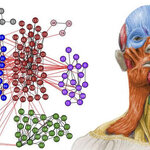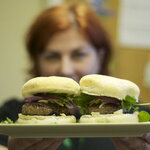Neuroscience

Anyone who knows me also knows that I have a huge sweet tooth.
I always have. My friend and fellow graduate student Andrew is equally afflicted, and living in Hershey, Pennsylvania – the “Chocolate Capital of the World” – doesn’t help either of us.
But Andrew is braver than I am. Last year, he gave up sweets for Lent. I can’t say that I’m following in his footsteps this year, but if you are abstaining from sweets for Lent this year, here’s what you can expect over the next 40 days.
Sugar: natural reward, unnatural fix
In neuroscience, food is something we call a “natural reward.” In order…

A new mathematical analysis tool can numerically describe the skull as an extended network structured in ten modules.
Anatomical Network Analysis (AnNA) is based on network analysis mathematical tools for studying anatomy and has led to several studies of both the human skeleton and of the rest of terrestrial vertebrates, especially in regard to the development and evolution of the skull.
Now researchers have added the head muscles and cartilages to the study of the skull bones, including the inner ear bones, the jaw and the bones that connect with head muscles, such as cervical…

People are not as conscious of tasting fat as they are of other taste qualities. John Benson, CC BY
By Russell Keast, Deakin University
Humans are thought to be able to taste five qualities but technological advances combined with sophisticated research means we can now test for more subtle tastes we haven’t known about. In a paper we published this week, we show there’s now enough evidence to consider fat a taste quality.
Taste acts as the gatekeeper of ingestion – if a potential food is deemed suitable for consumption it may be swallowed, if not rejected. To guide this decision, we have…

The brain’s GPS wouldn't be much value if its maps of our surroundings that were not calibrated to the real world - grounded in reality.
But they are, and a new study shows how this is done.
The way that the brain’s internal maps are linked and anchored to the external world has been a mystery for a decade, ever since 2014 Nobel Laureates May-Britt and Edvard Moser discovered grid cells, the key reference system of our brain’s spatial navigation system. Now, researchers at the Mosers’ Kavli Institute for Systems Neuroscience believe they have solved this mystery.
Think of regular maps…

A new study has shown an unprecedented degree of connectivity reorganization in newly-generated hippocampal neurons in response to experience, suggesting their direct contribution to the processing of complex information in the adult brain.
The hippocampus is an anatomical area of the brain classically involved in memory formation and modulation of emotional behavior. It is also one of the very few regions in the adult brain where resident neural stem cells generate new neurons life-long, thus providing the hippocampal circuitry with an almost unique renewal mechanism important for…

Learning disabilities may make life more of a challenge, but a diagnosis is not a life sentence. Shutterstock
By Sue O'Neill; Iva Strnadová, and Therese M. Cumming
For some children, despite having no known physical or mental disability, learning to read, write, spell, do maths, dress, throw and catch a ball, or organize themselves presents significant challenges. When childhood milestones involving speech and movement are slow to develop in young children, should parents be concerned that their child might have a learning disability?
Below we outline three learning disabilities and what to…

A new study has identified genes involved in long-term memory in the worm as part of research aimed at finding ways to retain cognitive abilities during aging.
The study identified more than 750 genes involved in long-term memory, including many that had not been found previously and that could serve as targets for future research, said senior author Coleen Murphy, an associate professor of molecular biology and the Lewis-Sigler Institute for Integrative Genomics at Princeton University.
A study conducted in C. elegans worms (left) revealed genes involved in forming long-term memories. These…

Inflammation has long a target in Alzheimer's disease studies so a new finding in Neuron is counterintuitive. In the study, researchers hace uncovered the mechanism by which anti-inflammatory processes may trigger the disease and this anti-inflammatory process might actually trigger the build-up of sticky clumps of protein that form plaques in the brain. These plaques block brain cells' ability to communicate and are a well-known characteristic of the illness.
The finding suggests that Alzheimer's treatments might need to be tailored to patients depending on which forms of Apolipoprotein E, a…

We use our hands a lot each day. Humans have highly developed fine motor skills and so we are able to perform grasping movements with variable precision and power distribution, everything from tying our shoelaces to holding a balloon.
It is ability is a fundamental characteristic of the hand of primates but is unclear how hand movements are planned in the brain. A recent research project of Stefan Schaffelhofer, Andres Agudelo-Toro and Hansjörg Scherberger from the German Primate Center has shown how different grasping movements in the brain are controlled in rhesus monkeys. Using…

A Western diet may be negatively affecting your brain not just your belly. Jams, CC BY-NC-SA
By Terry Davidson, American University and Camille Sample, American University
Do you eat only when you’re actually hungry? Many of us eat even when our bodies don’t need food. Just the thought of food entices us to eat. We think about food when we see other people eating, when we pass a favorite fast-food restaurant, when we see a scrumptious snack near the check-out at a convenience store. In addition, we’re the targets of sophisticated advertising techniques designed to keep thoughts of food and…